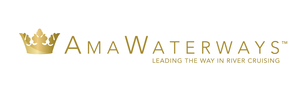Our award-winning AmaSonata sings her melodious tune down Europe's great rivers. Most accommodations have twin balconies, so you can enjoy the ever-changing scenery however you wish, along with amenities like Entertainment-On-Demand, high-speed Internet access and English-language TV stations. A soft color palette in each stateroom calms the mind for relaxation, but when you're ready to get active, head to the fitness center or up to the Sun Deck to the heated pool. Crisp white tablecloths and napkins grace the tables in the subdued Main Dining Room, while The Chef's Table specialty restaurant highlights its 5-star multi-course cuisine with gold-hued tones and a twinkling overhead centerpiece. With a stunning Main Lounge, tranquil library, sun-deck walking track, massage and hair salon, and gift shop, you'll never find a dull moment—and will sing AmaSonata's praises while sailing on board.
Cruise ID: 53299
Explore Europe's amazing sights like the locals do. We were the first river cruise line to carry an entire fleet of complimentary bicycles on board, so you can experience biking alongside enchanting riverside pathways and in city centers. Whether you feel like joining one of our exclusive guided bike tours, or want to go discover on your own, there are many ways for you to explore on two wheels during your cruise. The beauty of Europe doesn't just lie in its architecture and landmarks – there are also breathtaking sights to be seen when you venture out into nature. That's why we've designed special guided hikes that will take you a bit off the beaten path, offering a unique perspective in beautiful destinations such as Austria's UNESCO-designated Wachau Valley. All of our guided hikes and bike tours are included in the cruise fare so you have more choices when it comes to how you prefer to explore.
Although we leave gratuities to your discretion, many of our guests have asked for general tipping guidelines. Gratuities may be charged on a credit card or given in cash.
7-Night Cruise
Ship's Crew: The entire amount will be divided equally amongst all crew members. Recommendation: 100 Euros per 7-night cruise, per guest. (AmaMagna 120 Euros per 7-night cruise, per guest)
Cruise Manager: Your Cruise Manager is not part of the ship's crew and is the AmaWaterways representative who also accompanies you on any pre- and/or post-cruise hotel/land extensions you may have booked. Recommendation: 25 Euros per 7-night, per guest; 4 Euros for each additional day, per guest for pre- and post-cruise hotel/land extensions.
10-Night Cruise
Ship's Crew: The entire amount will be divided equally amongst all crew members. Recommendation: 143 Euros per 10-night cruise, per guest.
Cruise Manager: Your Cruise Manager is not part of the ship's crew and is the AmaWaterways representative who also accompanies you on any pre- and/or post-cruise hotel/land extensions you may have booked. Recommendation: 36 Euros per 10-night, per guest; 4 Euros for each additional day, per guest for pre- and post-cruise hotel/land extensions.
11-Night Cruise
Ship's Crew: The entire amount will be divided equally amongst all crew members. Recommendation: 158 Euros per 11-night cruise, per guest.
Cruise Manager: Your Cruise Manager is not part of the ship's crew and is the AmaWaterways representative who also accompanies you on any pre- and/or post-cruise hotel/land extensions you may have booked. Recommendation: 40 Euros per 11-night, per guest; 4 Euros for each additional day, per guest for pre- and post-cruise hotel/land extensions.
14-Night Cruise
Ship's Crew: The entire amount will be divided equally amongst all crew members. Recommendation: 200 Euros per 14-night cruise, per guest.
Cruise Manager: Your Cruise Manager is not part of the ship's crew and is the AmaWaterways representative who also accompanies you on any pre- and/or post-cruise hotel/land extensions you may have booked. Recommendation: 50 Euros per 14-night, per guest; 4 Euros for each additional day, per guest for pre- and post-cruise hotel/land extensions.

















